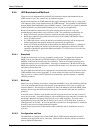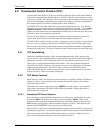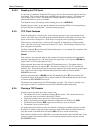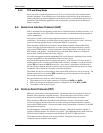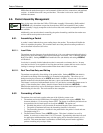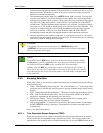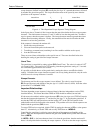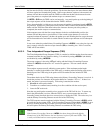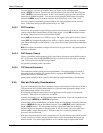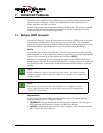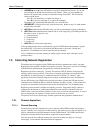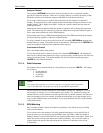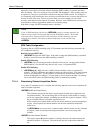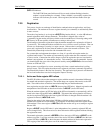
Feature Reference DART 300 Modem
Page 50 2110212 Rev 1.0
To ensure that you can enter the complete string, you cannot set the maximum packet
length (+WS74) less than 6. You must also provide sufficient time in the PAD Inter-Character
Timer (+WS70) to enter each character. If this is to be manually typed, the value should be set
quite high (or disabled altogether). You must also avoid setting the PAD Primary Forwarding
Character (+WS64) to one of the three characters in the TIES string (A=65, T=84, +=43).
Take note of the inter-relationship between TIES and the Time Dependent version described
above. Guard time settings can influence the ability to use TIES.
6.6.3.3. DTR Transition
Devices not able to send an escape character sequence can still transition from data to command
state by using the Data Terminal Ready (DTR) control signal. Use the &D command to control
the modem’s behaviour on an on-to-off transition of DTR.
Setting &D0 will disable the use of DTR for escape. The signal is still required for flow control.
Setting &D1 will configure the modem to use DTR as a signal to change from data to command
state without affecting the on-line condition. Any open session is kept open and the packet buffer
is retained.
&D2 will configure the modem to change state and close any open session. Any partial packet in
the buffer is discarded.
6.6.3.4. PAD Session Timeout
There is a possibility that the modem will lose signal and/or registration causing PAD sessions to
fail. TCP sessions issue the NO CARRIER message, close the session, and revert to command
state. UDP sessions issue the OK message instead.
Any partially assembled packet is discarded.
6.6.3.5. TCP Remote Disconnect
TCP connections include opening and closing handshakes. The remote terminal can initiate a
disconnection and the modem will close the session, issuing the NO CARRIER message. The
modem then reverts to command state.
Partial packet assembly at the local end is discarded if the remote handshakes a disconnection.
6.6.4. Data and Telemetry Considerations
If you are communicating data files or telemetry using one of the modem’s PAD services (UDP or
TCP) that do not involve direct human interaction, you should make appropriate changes to the
packet management features of the modem.
Exact settings will depend on the nature of your application and the quality of your network
connection. What follows are some issues to consider.
In almost all telemetry cases, the PAD editing features are disabled. Local echo and backspace are
turned off with +WS62=0 and +WS72=0 respectively.
If binary data is being communicated, you should disable the PAD Primary Forwarding Character
feature (+WS63=0) and use the PAD Inter-Character Timer (+WS70=5) and/or limited packet
length (+WS74) instead. This will prevent unusually small packets where the forwarding
character might occur frequently in the binary data. It will also ensure data is forwarded to the
network within a roughly known period. This allows the server to detect if problems have
occurred at the local host end.
If the data stream from the host occurs at timed intervals, the inter-character timer should be set to
as short a duration as feasible, allowing for brief stutters in the stream without missing the gap
between streams. The packet length should be set to a suitable length to capture each stream.



